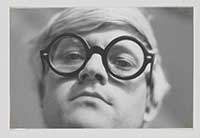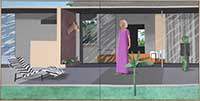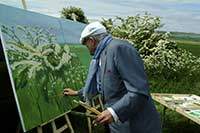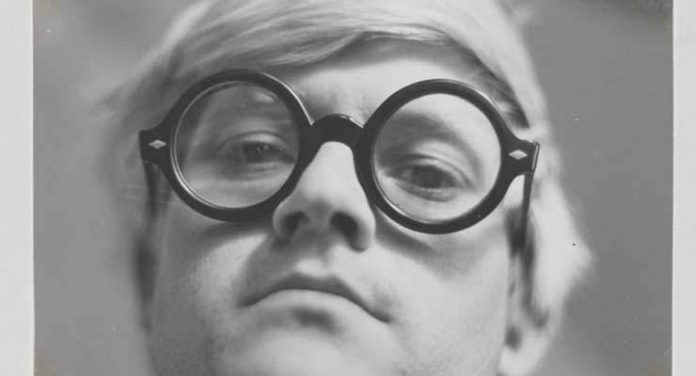
Hockney’s art is very visual, very abstract, and he has been able to transcend the changes in the art world for over half a century. He’s been a success, but throughout his life he has struggled with his art, relationships, and the tragedy of AIDS.
Hockney was brought up in the time of austerity, and his first memories are of 
But Hockney the documentary doesn’t show us his life story in chronological order. It goes back and forth between showing home videos of him with friends, present day Hockney musing on his life, friends from the yesteryear reminiscing about pivotal events in Hockney’s life, his sister Margaret discussing the time when they were children, and near the end of the documentary there is a three-minute tribute to his mother, who passed away in 1999 at the age of 99. So Hockney in that sense is a bit confusing because it doesn’t follow any order, it’s just a series of talking heads (including Hockney’s) interspersed with his work.
It is the art shown in the film that is breathtaking. Hockney created two very different landscapes for his work — the vast bright colorful spaces of California and the dark, moody hills of East Yorkshire. His work would start with a photograph, and from then he would reproduce it as a print, including friends and acquaintances in some of his paintings – some of whom discuss their memories posing for Hockney.

Peter Getting out of the Pool also stuck with this same motif — showing Hockney’s then boyfriend Peter Schlesinger literally getting out of the pool, naked, with the ripples of the water drawn by Hockney to look like squiggly lines. When the themes weren’t about pools or homosexuality, Hockney liked to paint people. Mr. and Mrs. Clark and Percy (1970) shows two friends posing in their living room. Hockney for some strange reason could not paint Mr. Percey’s feet so he had him burrow them in the deep shag carpet.
But David Hockney comes off as lonely. He has had bouts of depression during his lifetime, especially after the death of his best friend Henry Geldzahler – who passed away in 1994 of cancer. They were soulmates, traveling together, working together, and practically living together. Henry, who worked in the art world as a curator, is shown in bed with Hockney, cuddling, and shown at a beach house where he and Hockney would escape to be creative. Also AIDS entered into Hockney’s like, and his friends say that it shook him to his core. Hockney, who is free of the virus, says in the documentary that he lost two-thirds of his friends to the disease.
But Hockney always reinvents himself. His interest in films and photography grew into almost an obsession. He
Director Randall Wright was very fortunate in two respects in the making of this documentary; that Hockney was still alive, and that he fully cooperated with him for this documentary. Hockney gave Wright free rein to do whatever he wanted with his personal archives — the first time Hockney has ever done so. Hockney even gave Wright permission to use his many unseen experiments with film and video and early still photographs. This is not the first time that Wright has worked with Hockney. In 2003 he directed David Hockney: Secret Knowledge, which explored Hockney’s theory that artists have used optical devices since the 15th century. But in Hockney, it’s all about the man, and the myth. But perhaps Wright is too close to his subject and has known him for a long time because after watching Hockney I still felt that I didn’t really understand him and felt like I had just been given a video tour of his art — abstract to a point of not knowing what to make of it. And at the end of the documentary, we see Hockney aimlessly walking around his house, not giving much of a dramatic ending to this film.
Be the first to leave a review.

